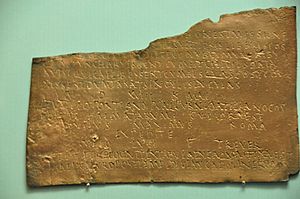Publius Mummius Sisenna facts for kids
Quick facts for kids Publius Mummius Sisenna |
|
|---|---|

Military diploma CIL XVI, 82, dated April 14th 135, showing he was a governor
|
|
| Roman consul |
Publius Mummius Sisenna was an important Roman politician. He held a top position called a consul in the year 133 AD. His partner in this role was Marcus Antonius Hiberus. Soon after, Sisenna became the governor of Roman Britain. It's thought that the famous Hadrian's Wall might have been finished while he was in charge there.
Some historians believe Sisenna's family originally came from Spain. This is based on his family's "tribe" name, Galeria, which was common in those areas.
Publius Mummius Sisenna's Career
We don't know a lot about Sisenna's early career. He served as a governor in Roman Britain. An old stone carving found at Wroxeter confirms this. It is dated April 14, 135 AD.
It was unusual for someone to become governor of Roman Britain so soon after being a consul. Sisenna was one of only three people to do this without governing another area first. This might have happened because the previous governor, Sextus Julius Severus, had to leave suddenly. He went to Judaea to stop a rebellion. The Roman Emperor Hadrian might have chosen Sisenna quickly because he was the best person for the job.
Another old writing shows that Sisenna was also a proconsul (another type of governor) in Asia Minor around 150–151 AD.
Family Connections
Publius Mummius Sisenna likely had a family connection to another important Roman named Publius Mummius Sisenna Rutilianus. Rutilianus became a consul in 146 AD. He also served as a proconsul in Asia, just like Sisenna.
Rutilianus was a commander of the Legio VI Victrix (Sixth Victorious Legion). This Roman army group was stationed in Britain. It's possible Rutilianus served there when Sisenna was governor. If they were father and son, it means the older Sisenna became consul later in his life. This is because his son became a consul only thirteen years after him.

